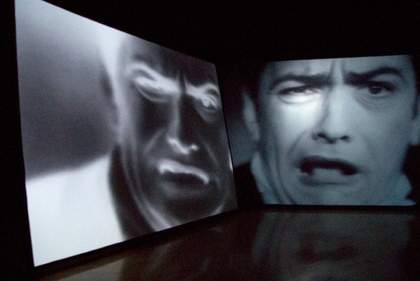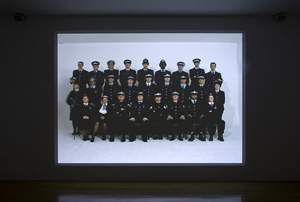The nominations in these years raised questions about gender parity within the art world and also reflected the increasing use of video.
In 1996 an all-male shortlist attracted some disapproval in a year when young female artists had been particularly visible. The selection of an all-female shortlist in the following year – the first in the prize’s history – was seen by some as an attempt to rectify this imbalance. Others accused the jury of overt political correctness. Douglas Gordon was the first artist working with film and video to win the prize confirming the growing acceptance of these mediums.
This was reinforced when Gillian Wearing was awarded the prize in 1997, for her work with film and photography.
Artists and works on display:

Douglas Gordon
Confessions of a Justified Sinner 1995
Video installation, two parts, each 300 x 400 cm
Fondation Cartier pour l'art contemporain, Paris
© Courtesy Lisson Gallery and the artist Photo: Tate Photography
Douglas Gordon
Confessions of a Justified Sinner 1995
Video installation
Two parts
Fondation Cartier pour l’art contemporain, Paris
In the early 1990s Douglas Gordon produced a series of projected works using fragments of existing film footage which he manipulated in order to draw the viewer’s attention to unseen details. These works investigate the psychological impact of the moving image and themes of perception, memory and voyeurism.
Confessions of a Justified Sinner combines three clips from an early film version of R.L. Stevenson’s novel The Strange Case of Dr Jekyll and Mr Hyde that capture saintly Jekyll transforming into monstrous Hyde. The footage is enlarged, slowed down and projected onto two separate screens, one negative and one positive, in order to prolong and blur the two states.

Gillian Wearing
60 minute silence 1996
Video single screen
60 min
Arts Council Collection, Southbank Centre, London
Gillian Wearing
60 minute silence 1996
Video single screen
60 min
Arts Council Collection, Southbank Centre, London
Gillian Wearing has often collaborated with members of the public to make her photographs and videos – in this case she worked with twenty-six police officers. Initially the viewer appears to be presented with a life-size photograph. However, slight movements and individual shuffles make it apparent that this is a real-time moving image.
Wearing requested that the group remain still over a sixty-minute period and as the time progresses the tension builds, raising prevalent questions about control and surveillance. When the hour is up, one officer releases a cry of relief, breaking the tense silence.
